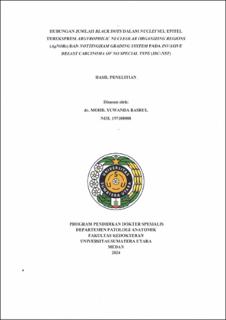| dc.contributor.advisor | Delyuzar | |
| dc.contributor.advisor | Intan, T Kemala | |
| dc.contributor.author | Basrul, Mohd Yuwanda | |
| dc.date.accessioned | 2025-07-04T06:28:41Z | |
| dc.date.available | 2025-07-04T06:28:41Z | |
| dc.date.issued | 2024 | |
| dc.identifier.uri | https://repositori.usu.ac.id/handle/123456789/104900 | |
| dc.description.abstract | Background: Breast cancer is a malignant disease in women. The high number of breast cancer cases is caused by multiple factors, including barriers to early detection of breast cancer, socio-economic and geographical factors, and the difficulty of affordable, timely and effective health services. IBC-NST has the highest incidence among breast cancer cases to 10 years survival rate (65-78%). AgNORs parameters have been shown to represent a reliable tool for determining the clinical outcome of cancer diseases, being an independent prognostic factor in many types of tumors.
Objective: To determine the relationship between the number of black dots in epithelial cell nuclei expressing Argyrophilic nucleolar organizing regions (AgNORs) and the Nottingham grading system in Invasive breast carcinoma of no special types (IBC-NST).
Materials and Methods: Descriptive analytics research was carried out on slides from 31 patients with Invasive breast carcinoma of no special types (IBC-NST). Each slide was stained with Hematoxylin-Eosin (H&E) to assess the Nottingham grading system and stained with Argyrophilic nucleolar organizing regions (AgNORs) to assess the number of black dots in epithelial cell nuclei that expressed AgNORs. All clinicopathological data were taken from medical records/pathology archives. Logistic regression test (p<0.005) was used to assess the relationship between the number of black dots in epithelial cell nuclei expressing Argyrophilic nucleolar organizing regions (AgNORs) and the Nottingham grading system in Invasive breast carcinoma of no special types (IBC-NST).
Results: Among the 31 specimen samples, the highest cases were in the age group ≤40-50 years (range: 50.1 years), the highest grading was in grade 3 of the Nottingham grading system (15 samples, 48.8%), the lowest number of black dots at 576 points and the highest was 1,036 points (mean 798.80, median 710.0 and standard deviation 144.71) and the highest number of black dots was in grade 3 of the Nottingham grading system.
Conclusion: There is a relationship between the number of black dots in the nuclei of epithelial cells expressing Argyrophilic nucleolar organizing regions (AgNORs) and the Nottingham grading system. | en_US |
| dc.language.iso | id | en_US |
| dc.publisher | Universitas Sumatera Utara | en_US |
| dc.subject | AgNORs | en_US |
| dc.subject | Silver Stain | en_US |
| dc.subject | Black Dots | en_US |
| dc.subject | Nottingham Grading System | en_US |
| dc.subject | Invasive Breast Carcinoma of No Special Types | en_US |
| dc.title | Hubungan Jumlah Black Dots dalam Nuclei Sel Epitel Terekspresi Argyrophilic Nucleolar Organizing Regions (AgNORs) dan Nottingham Grading System pada Invasive Breast Carcinoma of No Special Type (IBC-NST) | en_US |
| dc.title.alternative | Relationship of the Number of Black Dots in the Nuclei of Epithelial Cells Expressed Argyrophilic Nucleolar Organizing Regions (AgNORs) and the Nottingham Grading System in Invasive Breast Carcinoma of No Special Type (IBC-NST) | en_US |
| dc.type | Thesis | en_US |
| dc.identifier.nim | NIM197108008 | |
| dc.identifier.nidn | NIDN0019026301 | |
| dc.identifier.nidn | NIDN0024046211 | |
| dc.identifier.kodeprodi | KODEPRODI11754#Patologi Anatomik | |
| dc.description.pages | 87 Pages | en_US |
| dc.description.type | Tesis Magister | en_US |
| dc.subject.sdgs | SDGs 3. Good Health And Well Being | en_US |


